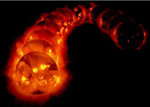 |
Goddard Space
Flight Center NASA > GSFC > Astrophysics Science Division > IXO |
|
Stellar Magnetic FieldsHow do magnetic fields shape stellar exteriors and the surrounding environment? Magnetic reconnection is believed to give rise to a variety of different astrophysical phenomena, from radio and auroral emissions on giant planets to accretion disk flares in AGN. X-ray observations of late-type stars probe the tenuous hot coronal plasma produced by non-radiative heating processes. IXO will probe the detailed plasma physics of structuring and dynamics on timescales and on classes of stellar objects in which it is not currently possible. Such observations will enable a more detailed examination of the physics involved in how magnetic fields shape stellar exteriors and the surrounding environment 
Yohkoh images of the Sun taken over the course of a solar cycle, illustrating the difference in solar coronal structures from maximum to minimum. Courtesy of G.L. Slater, G.A. Linford, S.L. Freeland, the Yohkoh Project . Click the image for a larger view. Because of the correlation between X-ray emission and magnetic field, our current capability to study "stars as suns" is limited to those stars with large magnetic filling factors. Large collecting area coupled with adequate spectral resolution, such as provided by IXO, is needed to determine the important plasma properties of density and abundance, necessary to infer coronal structures on stars which may be representative of the Sun at its activity cycle minimum. 
Chandra light curve [left] and CCD spectrum [middle] showing the Fe 6.4keV fluorescent line during a powerful flare from the protostar YLW16A in the nearby Ophiuchi cloud (from Imanishi et al. 2001). The high-ionization emission lines (6.7keV) arise from the hot plasma confined in the flaring magnetic loop. [right] Simulation of a 2ks IXO XMS spectrum at the onset of the YLW16A flare showing the Fe 6.4 keV fluorescent line. IXO will be able to see flares 100x fainter than currently possible. From Feigelson et al. white paper. Click the image for a larger view. For more information, refer to IXO Astro 2010 Decadal White Papers: Mass-Loss and Magnetic Fields as Revealed Through Stellar X-ray Spectroscopy, R. Osten et al. |